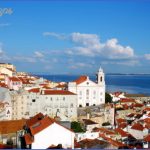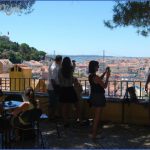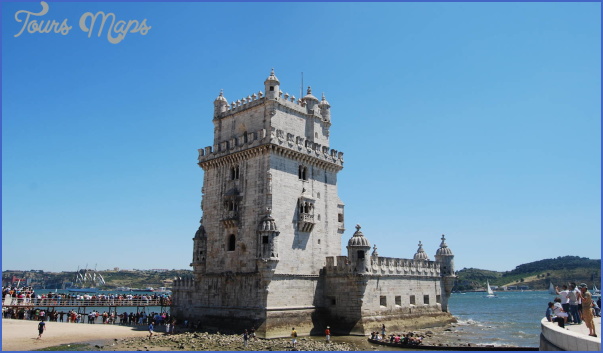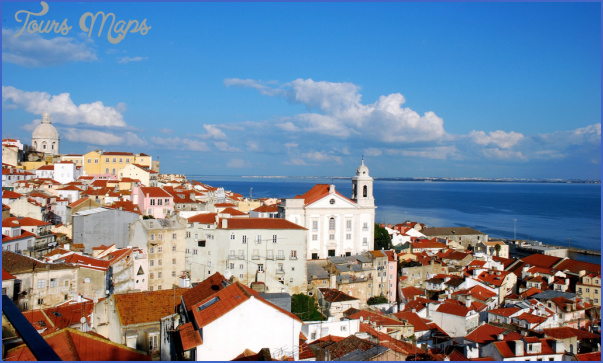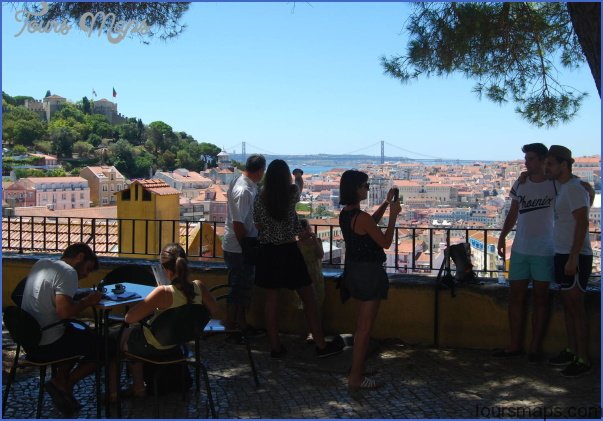Lisbon Guide for Tourist
RATO
Across from the Basilica on Lg. da Estreia, the wide paths of the HJardim da Estreia wind through flocks of pigeons and lush flora and make a perfect spot for a stroll. (M: Rato. With your back to the Metro stop, take the 2nd road from the left, R. Pedro Alvares Cabral; follow it lOmin. until it runs into the garden. Open daily 8am-9pm.)
BASfLICA DA ESTRELA. Built in 1796, the basilica’s dome, poised behind a pair of tall belfries, peaks out from surrounding buildings and trees to take its place in the Lisbon skyline. Half-mad Maria I, desiring a male heir, made fervent religious vows promising God everything if she were granted a son. When a baby boy was finally bom, she built this church, and admirers of beautiful architecture and ornate wall paintings have been grateful ever since. Ask the sacristan to show you the 10th-century manger scene. (On Pr. da Estreia. Accessible by Metro or by tram #28 from Pr. do Comercio. Open daily 8am-12:30pm and 3-7:30pm. Free.)
ALFAMA
Alfama, Lisbon’s medieval quarter, was the lone neighborhood to survive the infamous 1755 earthquake. The area descends in tiers from the dominating Castelo de Sao Jorge facing the Rio Tejo. Between Alfama and Baixa is the quarter known as the Mouraria (Moorish quarter), ironically established after Dom Afonso Henriques and the Crusaders expelled the Moors in 1147. Here, Portuguese grandmothers gossip and school boys play soccer amidst the few camera-toting tourists. Muggers make nighttime visits imprudent; even during the day, handbags should be left securely in hotels or lockers. Though sightseeing by foot in Alfama can be fun, visitors can also hop on tram #28 from Pr. do Comercio (‚ 1), which winds up through the neighborhood past most of its sights.
THE LOWER ALFAMA. While any of the small uphill streets east of Baixa lead to Alfama’s maze of streets, perhaps the best way to see the neighborhood is by climbing up R. da Madalena, which begins two blocks away from Pr. do Comercio. Veer right when you see the Igreja da Madalena in the Lgo. da Madalena on the right. Take R. de Santo Antonio da Se, and follow the tram tracks to the small Igreja de Santo Antonio, built in 1812 over the beloved saint’s alleged birthplace. The construction was funded with money collected by the city’s children, who fashioned miniature altars bearing images of the saint to place on doorsteps a custom reenacted annually on June 13, the saint’s feast day and Lisbon’s largest holiday. (Open daily 8am-7pm. Mass daily 11am, 5, and 7pm.)
CASTELO DE SAO JORGE. Near the top of the Alfama lies the Castelo de Sao Jorge, which offers spectacular views of Lisbon and the ocean. Built in the 5th century by the Visigoths and enlarged in the 9th century by the Moors, this castle was again improved and converted into a playground for the royal family between the 14th and 16th centuries. Wander around the ruins, soak in the views, explore the ponds, or gawk at the exotic birds in the gardens. For shoppers, the castle also includes a string of souvenir shops and restaurants. (From the cathedral, follow the brown and yellow signs for the castle on a winding uphill walk. Castle open daily Apr.-Sept. 9am-9pm; Oct.-Mar. 9am-6pm. Free.)
GRAQA
The construction of the H Panteao Nacional (formerly the Igreja de Santa Engracia) began in 1680 and continued some 280 years, as the church changed hands between Catholic monks, enterprising factory owners, and ultimately, the dictatorial regime of Salazar. At its completion in 1966, the dome was dedicated as a burial for illustrious statesmen. Today, it houses the remains of such national figures as queen offado Amalia Rodrigues. (To reach Graf a and the Panteao, take bus #12 or tram #28 from the bottom ofR. dos Correiros. Open Su and Tu-Sa 10am-5pm. ‚2.)
SAO SEBASTIAO
Home to Lisbon’s first Corte Ingles, this section of town marks the entrance to two excellent art museums.
UMUSEU CALOUSTE GULBENKIAN. When oil tycoon Calouste Gubenkian died in 1955, he left his extensive art collection to his beloved Portugal. Though the philanthropist was of Armenian descent and a British citizen, it was Portugal he chose to call home. The collection is divided into sections of ancient art Egyptian, Greek, Roman, Islamic, and Oriental and European pieces from the 15th to 20th centuries. Highlights include works by Monet, Rembrandt, Renoir, and Rodin. (Av. Berna 45. M: Sao Sebastiao. Bus # 18, 46, or 56. Open Su and Tu-Sa 10am-6pm. ‚3. Seniors, students, and teachers free.)
CENTRO DE ARTE MODERNA. Though not as famous as its neighbor, this museum, also funded by Mr. Gulbenkian’s foundation, houses an extensive modem collection dedicated to promoting Portuguese talent. Don’t miss the sculpture gardens that separate the two museums. (R. Dr. Nicolau Bettencourt. M: Sao Sebastiao. From the station, head downhill; the museum is tucked among the trees. Bus #16, 31, or 46. Open Su and Tu-Sa 10am-5pm. ‚3. Seniors, students, and teachers free.)
Lisbon Guide for Tourist Photo Gallery
Maybe You Like Them Too
- Explore Góra Kalwaria, Poland with this detailed map
- Explore Gumdag, Turkmenistan with this detailed map
- Explore Telfes im Stubai, Austria with this detailed map
- Explore Langenselbold, Germany with this detailed map
- Explore Krotoszyn, Poland with this detailed map


